HOME > Dental Fillings
Dental Fillings
Dental Fillings

When doctors prescribe medicines, they usually provide information to explain what kind of drugs they are and how to take them. It seems to be strange that we don't usually receive something similar when we have our teeth filled at the dentist.
Gold, silver and palladium alloy is the most commonly used material which is covered by national health insurance.
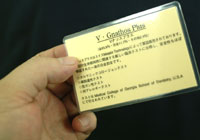
A card which is given to patients at our clinic to explain about metal alloy.
Background on how this alloy was approved for coverage by national health insurance.
Around 1960 in the dentistry field in Japan, there was a movement to make less costly "copper/zinc" alloy an alternative metal alloy for dental fillings due to the bad economic climate post world war II. However, metal used in the mouth where it is under extremely severe conditions should be chemically and biologically stable and non-corrosive like gold or other precious metal alloys.
The Japan Prosthodontic Society established a dental metal standards committee to standardize dental metal alloys and their testing methods, and to evaluate alloys. As a result of their activities it was determined that copper/zinc alloy was not suitable as a dental filling and was not introduced. The committee also determined that a gold, silver and palladium alloy was the minimum permissible standard to be used if the economic factors of the day made it necessary. Although, it was stated that it should be switched over to a better standard of gold alloy at the earliest possible time. (Clinical Medicine for Metal Allergies for GP's - by Masayuki Inoue)
Note: The above change to a better standard of alloy is yet to have taken place.
Mercury in Dental Fillings.
What is mercury amalgam?
Mercury amalgam used for dental fillings contains approximately 50% mercury and various other materials. It is generally said to be a stable alloy and is covered by national health insurance. Despite this, recent research with advanced technology identifies the ability of mercury to slowly leach out of the tooth and into the body. Mercury vapor also escapes from dental fillings into the sinus cavity, brain, eyes, ears, heart, nervous system and other organs, resulting in mercury poisoning (neurotoxin). The ministry of Health, Labor and Welfare that approves such filling material for coverage by national health insurance is obviously aware of these the facts. The question is, why is nothing being done about it? The senior dentist at our clinic enquired and got the answer from them but it's not possible to reveal it to the public here because it could cause riots. They seem eager to hide problems and do not think about peoples' wellbeing.
<photos>
- Mercury amalgam fillings
- When amalgam is removed in the US, dentists wear protective masks.
- When we remove amalgam at our clinic, we use a rubber dam to avoid breathing or swallowing mercury vapor or fragments as well as wear protective glasses and masks.
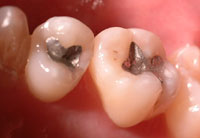

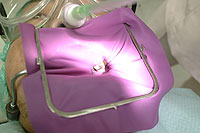
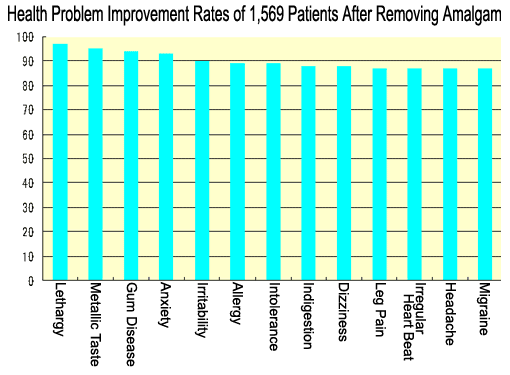
Extract from Dentistry Without Mercury - by Sam Ziff and Michael Ziff D.D.S.
Publisher: Bio -Probe.
Reference Book "Kuchi no naka ni hiromu kyofu (Terror in the Mouth) by Dan Steinberg"

People may be encouraged by the high improvement rates shown in the graph but mercury is highly toxic and known to be the cause of "Minamata disease". Therefore it is surprising that the use of this kind of material is covered by national health insurance. When you decide to have your dental fillings removed, do not take it lightly as extreme care must be taken when removing them. Swallowing a piece of mercury or inhaling mercury vapor could aggravate the symptoms of mercury poisoning. Additionally, what to use as a replacement is an important issue.
Metal in the mouth working as an antenna for electromagnetic radiation.
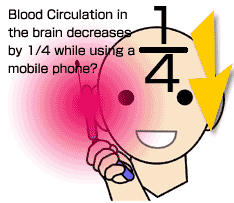
According to a research report, it has been shown that 95% of the known cases of chronic fatigue syndrome are caused by electromagnetic radiation hypersensitivity associated with the use of computers and mobile phones. Another report states that blood circulation in the brain is reduced by up to 1/4 when putting a mobile phone to the ear for 30 seconds. Since mobile phones are small, it is easy to think that they create less electromagnetic radiation than computers, but in actual fact, this radiation penetrates into organic tissue with more intensity because it is in the form of microwaves.
Also, electromagnetic radiation intensity is directly related to distance so using a mobile phone close to the brain could have an adverse effect.
Due to the decreased blood circulation in the brain, it is possible that dizziness, unsteadiness, fuzziness and headache may occur. These conditions which normally are diagnosed as nothing unusual by doctors could be occurring due to the metal in dental fillings acting as an aerial for electromagnetic waves.
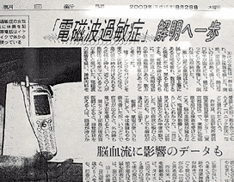
It is not uncommon for people to be diagnosed with "panic syndrome" or "chronic fatigue syndrome" because they have had falls while on the train (these conditions occur more often on the train since it is enclosed and electromagnetic waves cannot escape) or to have fuzziness and lethargy. They are commonly told the conditions are stress related and given anti-depression drugs, tranquilizers or sleeping tablets. The patients take the drugs because the symptoms improve temporarily, and after a while, they find themselves unable to stop although they want to. These people suffer because the Japanese government doesn't acknowledge the effects of electromagnetic radiation on organisms.

![]()
![]()
Video: Patient falls when a mobile phone is put on her chest.
Electromagnetic Radiation Experiment

Put a cellular phone (which is on) on your chest and stand at your ease. If you feel dizzy, unsteady, nauseous, tightness in the chest, numbness in the arms, or throbbing of the heart (symptoms vary from person to person), you might be hypersensitive to electromagnetic radiation.
The photo, left, is of a person having a mobile phone put close to their ear. It is evident that the subject is considerably affected due to electromagnetic hypersensitivity. We also found that the effects are even more pronounced if the phone rings during the experiment.

According to a thesis about sense, balance and electromagnetic radiation, one out of five people has this kind of syndrome. If the symptoms described above were to happen when a person was standing on the edge of a platform, it would not be surprising of they were to fall off onto the train tracks.



